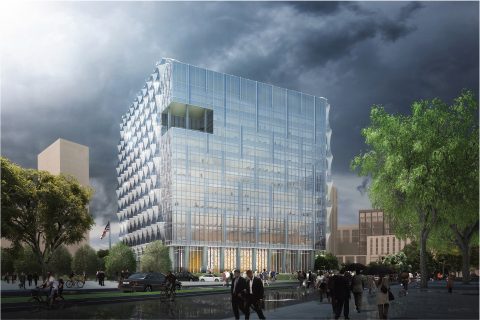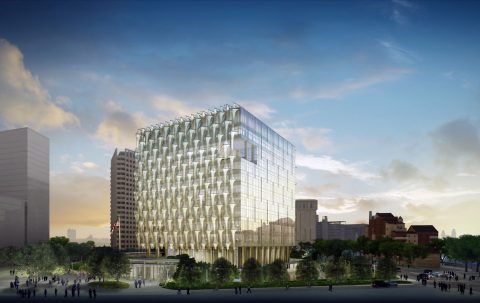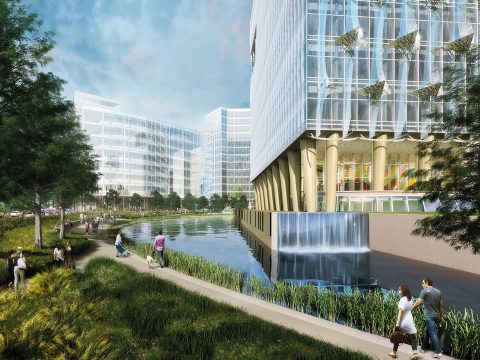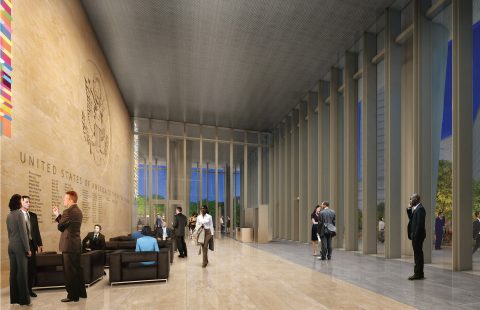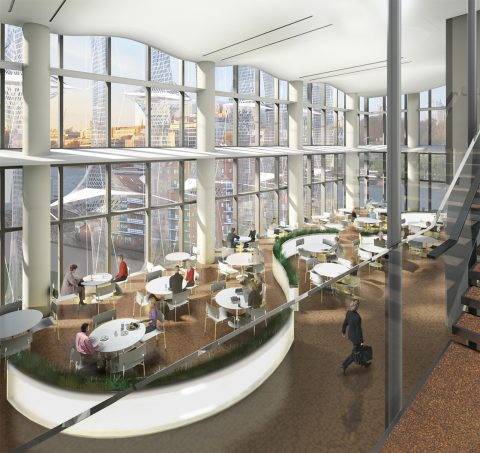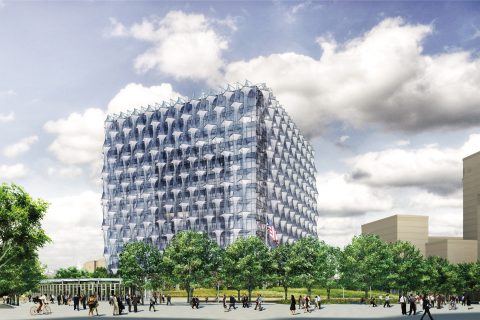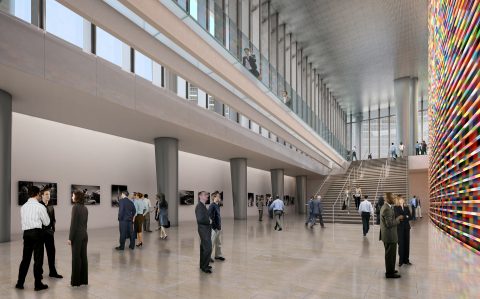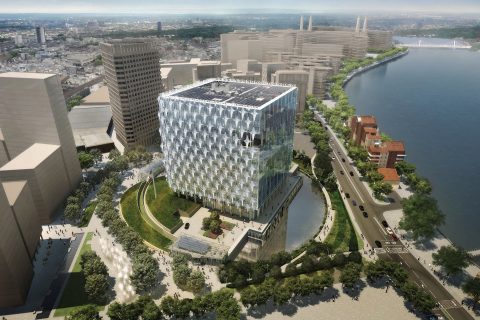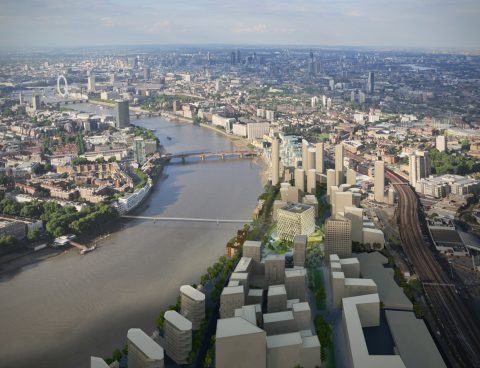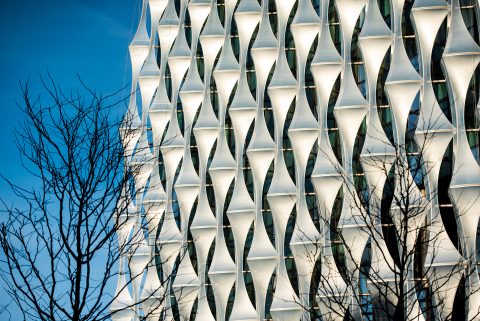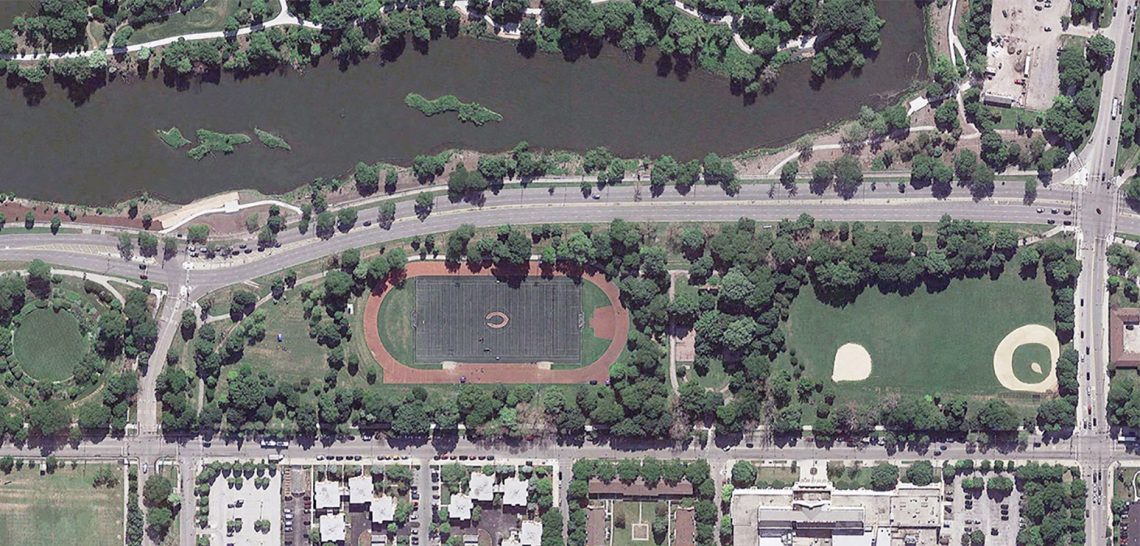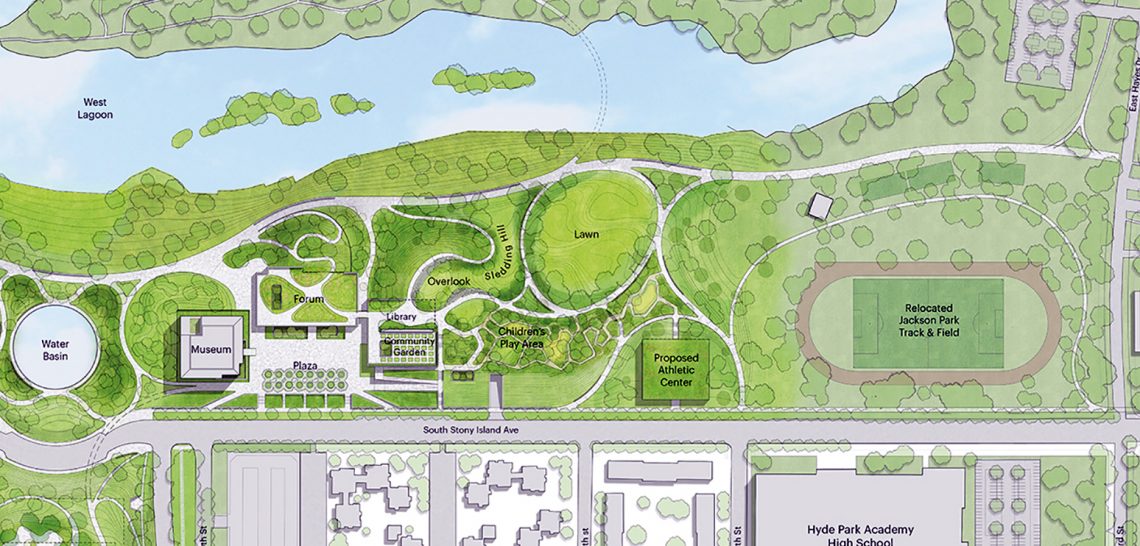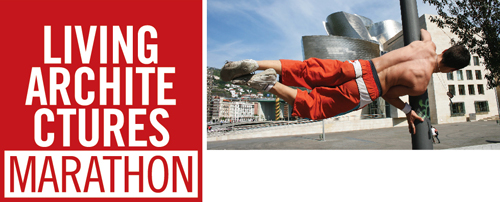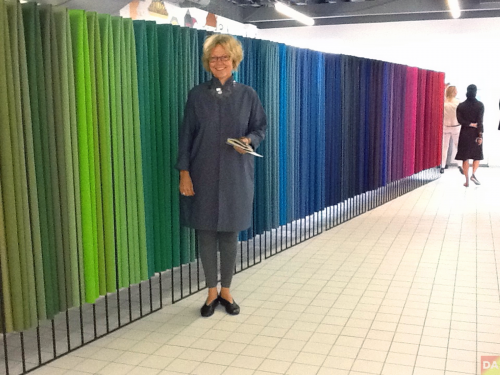 susan lyons
susan lyons
We’re talking to Susan Lyons, new president of Designtex.
[DesignApplause] Where was Designtex maybe a year ago, and where were you a year ago? And where are we today?
[Susan Lyons] We’re a 50-year old company. Started by two gentlemen who came together to develop products. Their first product was Verel, a flame retardent woven drapery fabric for the glass wall buildings being erected 50 years ago. This new architecture precipitated objections, mostly from the architects, who wanted a monolithic visual surface. You see, when people move in, there’s a lot of visual chaos in the windows.
That first drapery product, satisfying a need, I think, really started the company down a path towards always looking at ways to combine aesthetic problem solving and performance-based solutions.
Back to your question. A year ago, Designtex was in this showroom space here at Neocon. They had just purchased a large format digital imaging company. This acquisition could propel us into mass customization just-in-time manufacturing, and was one of the things that drew me back to the company. It seemed like a wonderful additional toolkit that we could offer to our clients.
I think one of the things that we’ve always been about and will be about going forward is offering architects and designers a plethora of tools to use to manifest their creative visions for their clients. The large format imaging opportunity was very, very exciting.
A year ago as the imaging thing was picking up speed, we found ourselves focusing less on developing a broader range of textiles. So we’re really trying to bring that back. A year ago, where was I? I was the Creative Director for Materials for Herman Miller. And I loved it, and I love them. But this opportunity presented itself.
[DA] How long were you with Herman Miller?
[SL] I started working with Herman Miller in 2007 and was with them for six years, as a consultant. Before that I was at Designtex from 1989 to 2002, leaving as their creative director to start my own business.
[DA] You’re a creative director in textiles. Are you a textile expert or a designer?
[SL] I never had formal training, but had opportunities to learn on the job. When I was a senior in college I started a tee-shirt printing company. The idea was done as an independent study that was called ‘The Alliance of Art and Culture in Contemporary Life.’ You know, one of those titles you put together to get your advisor to sign off on. I asked two partners to come in and the business went from printing 10 shirts at a time to printing a thousand. Three years later, another partner, a retired stockbroker who eventually bought the entire business.
Then I had an opportunity to go to India and work with a family who owned textile mills in Ahmedabad, India, where Ghandi was from. And I lived with them, worked with them for six months. They were interested in preserving the traditional methods of textile manufacturing, even though they were owners of large industrial factories.
[DA] What year was this?
[SL] 1980. Though they owned these large factories, they were interested in making sure that the villages doing block printing and silk screening and sari and quilt making would still have those opportunities. I was brought in to develop a product that could be exported to the West, to develop a distribution channel.
I worked with all the local artisans. Together we designed a 100 new wood blocks that were more contemporary but used traditional methods. And we developed textiles and quilts and pillows, products that ended up being sold through Habitat in the UK, now The Conran Shop.
That was a great experience for me, I learned a lot about the resources that were available in India including the hand weavers. I came back to the States, showing anybody and everybody all the stuff that I had with me. One women said, ‘Oh, you’re a textile designer,’ and sent me to owner Robin Roberts of Clarence House, a very high-end textile company.
I looked them up in Interior Design Magazine, pre-Internet you know. They made eighteenth century chintz and my work is very minimal, like no way. But this very interesting man said, “I don’t know what to do with you, but this is cool. Why don’t you come and work with us?” So I learned about print design, with him.
Then an opportunity to work at Boris Kroll Fabrics, a company that combined advanced weaving technology with an original and enduring color sensibility. I was made the director of product development and with no weaving experience found myself working on the looms, really hands-on experience, and something I’m quite proud of. I was there for 4 years and Mr. Kroll was still alive, and he was a great teacher and he tought me.
Ironically I ended up at Designtex the first time. And then left. That’s the story. A checkered past.
[DA] Very checkered, but you know what, it also isn’t. It’s pretty focused.
[SL] Yes, I think so. It’s just one of those things where having opportunities to actually get your hands on the making part of it. I love factories, and I love to see how things are made. So to have the opportunity where I had the chance to work for companies that were manufacturers and were makers, is great.
[DA] So you’re now the president. Have you given up your loom and acquired a suit?
[SL] No suit, no suit. You know, when this position came up I had this interesting thought: I’ve designed products and thought, ‘I wonder if I can design a company?’ What would the company look like and how would I do it?
I do see this as a design project. How do you design operations? How do you design product development? The thinking evolved to how do you use design thinking to actually change an organization? How can you design a culture? How could you design an ethos for a company? How could you design its operations?
We have great people internally, fantastic teams. We’re going through a process now that we’re calling ‘simplexity,’ where all of the departments are basically taking themselves apart to then put themselves back together. It’s using those things you know as a designer but applying them to a different set of problems.
[DA] What’s the relationship with Steelcase?
[SL] We’re an independent brand. We’re an independent subsidiary, so we operate independently. We are part of them, we partner with them when it makes sense.
[DA] What’s Designtex’s mission?
[SL] Our role and our mission is really to help the indie community realize their creative vision. So we work with them, and if they decide they want to work over here, we go there with them. Steelcase is a great company to be partnered with, but we also work with, more or less anybody.(laughing.)
[DA] Is Designtex worldwide?
[SL] We are semi-worldwide, I would say. One of our goals for this year is to build a solid international distribution model. We’re very strong in North America, Canada, Mexico, via NAFTA, We have representation in Asia and Australia,
[DA] Were you on Heimtextil? What other shows?
[SL] We’re not a big fan of trade shows. We invest in face-to-face relationships with our sales reps to our clients. We’re at Neocon but I’m not sure where we’re going to show next year. We’ve done various shows over the years, but our big investment is the product, our people and let them work their magic.
[DA] What have you learned since you got this new hat?
[SL] I’ve learned a lot. And I’m learning everyday. We have a good team and I learn from them. I learn from our vendors, we have fabulous mills and suppliers that we work with. Our organization has about 220 people, so I’m learning how you do that. It’s learning how to communicate more effectively. How to can keep everyone motivated. How to crowdsource ideas with your people. My job is fascinating has been an interesting learning curve for me.
[DA] What are Designtex’s services and who’s your customer?
[SL] We already talked about the indie companies. We do a lot of custom work. In the hospitality market, particularly. We have a really strong technical services department so if somebody needs a particular performance product problem to solve, we’re good at that. We now are adept with the digital imaging, and that’s all custom at the moment.
We have a factory up in Portland, Maine, that is peopled by, and run by artists. This factory’s focus is on artistic problem solving. Many of them are very accomplished photographers and painters. They take their skills used in their own work and bring it to our factory, and help our clients develop exciting solutions for their projects.
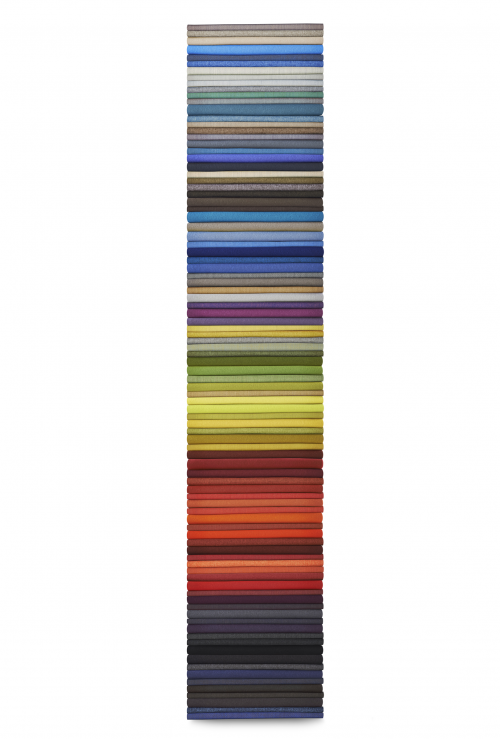 color wheel collection | “all colors are friends of their neighbors and lovers of their opposites.” —marc chagall
color wheel collection | “all colors are friends of their neighbors and lovers of their opposites.” —marc chagall
Color is the foundation of a designer’s tool kit, so Designtex has created a color system. The Color Wheel Collection consists of seven textures offered in an expansive range of 250 hues built using Pantone color references. This program allows designers to easily build palettes of primary, secondary, and tertiary colors that are complementary or analogous across the color spectrum.
We’re starting to create standard products as well, but what’s exciting is on-demand manufacturing. For example, we just finished a fantastic project with Rolls-Royce where they wanted panels that could be changed out very easily. We have a magnetic wall system with an image on top of a flexible ferrous material that can just be peeled off, so it looks very architectural, built-in. ‘Swap out’ is very easy and inexpensive. And a very good environmental story too, because you’re not having to rip the things down and replace them with new material.
[DA] Do you do furnishings?
[SL] No, we don’t do furnishings. We do surfacing materials. From upholstery to wall coverings to space division materials.
[DA] Do you make smart fabrics? Fabrics that clean themselves or can change color?
[SL] We’re looking at it. Nothing to talk about yet. But Designtex always had a really strong R&D presence. We brought Carol Derby from our environmental research department and promoted her to vice president of R&D. We’ve always liked combining science and art. Looking at ways to use less material and make materials smarter.
DA] What’s really exciting right now?
[SL] A big answer question. A lot of the answers right now are in 3-D printing. I’m also excited about what the large format for digital imaging can be. I think up until now it’s been used in a prosaic way: The big flowers or photographic scenes on wall panels. There’s room for more creativity. Not to just make art but to make meaningful products. We’re just starting to explore what it can be.
We’ve always been interested in collaborating with other people. Twenty years ago we were working with people within the built environment but weren’t textile designers, per se. Projects with Aldo Rossi and Bob Venturi and Denise Scott Brown, Richard Meier and Chillida. We did quite a few explorations with Pratt Institute. We had a division called One Plus One, now we’re calling it Designtex Plus. So we’re going to begin to see a series of collaborations under that name.
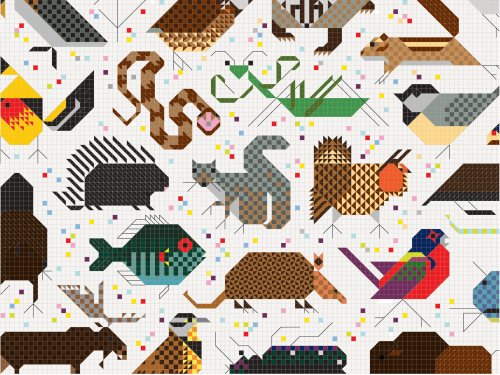 charley harper
charley harper
The first one we’re doing is called Designtex Plus Charley Harper. I’ve always loved Charley’s work, and I was talking to Todd Oldham, who’s the steward of the archive, and said, “You know, wouldn’t it be great to use Charley’s imagery for a collection, a collection around wellness?” Just because for me, his stuff just makes you feel good. We thought it would be fun to explore how we could take Charley’s work into a healthcare environment. As we’ve been working on it I’m feeling it’s really going to be more about well-being, a much broader interpretation.
Another big focus, of course, we’ve always had a strong interest in environmental product development, trying to move our materials, constantly optimize our materials, and make them better and more sustainable. An example is a new upholstery line called the ‘Gold Standard Collection’ and we like to say it’s so green it’s Gold—NSF/ANSI 336 Gold. The Gold Standard Collection is the first upholstery fabric ensemble to attain this third-party verified certification at the Gold level, demonstrating a commitment to both the environment and the well-being of the end user.
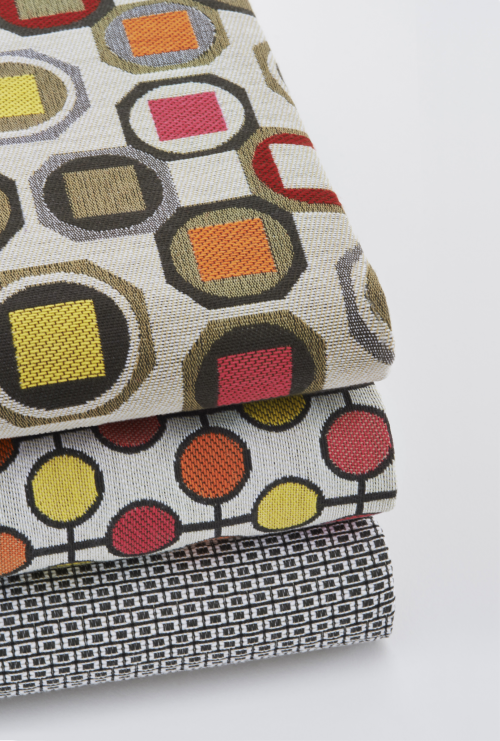 gold standard collection
gold standard collection
This is a fun story. A lot of our product is done in post-consumer recycled polyester, and as you probably know, that comes from, a lot from bottle chip. What’s happening in this market, finally, a lot of the beverage companies want their bottles back. They’re taking custody of their materials back, and it’s getting harder and harder to harvest the polyester yarn from just the bottles.
So we thought, we need to start harvesting other waste streams for material. For white yarn we stick to the method just described: we use the bottle chip which becomes resin pellets which leads to post-consumer white yarn.
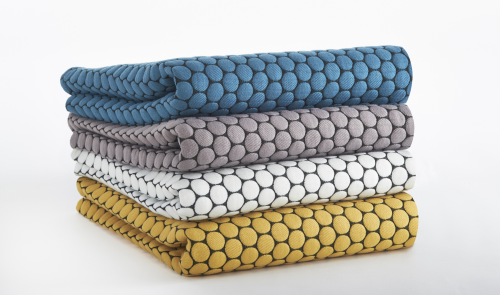 loop to loop
loop to loop
For color we go one step further. We take all waste from the Steelcase panel plant in Athens, Georgia, which becomes resin which leads to a gray solution-dyed yarn. Solution dyeing is a yarn coloration process in which pigment (all the multiple colors of the waste) is added to the polymer melt before the fiber is extruded into yarn. The color, therefore, is an inherent part of the yarn itself. We can now over-dye this fabric into any color that want. And this product is also recyclable. Well more than that even: It’s the first upholstery made from recycling already recycled textile waste.We call it Loop to Loop because it achieves a closed loop process for products within its supply chain.
[DA] So recyclable on steroids.
[SL] Exactly. This is a platform we’re going to continue to develop.
Designtex is a design and product development firm that celebrates inquiry and collaboration. A Steelcase company, the Designtex offering includes upholstery, wallcovering, panel fabrics, drapery, architectural panels, and digitally-printed surfaces. Designtex maintains showrooms, offices and sales locations in 110 global locations.
[ designtex ] [ steelcase ]




